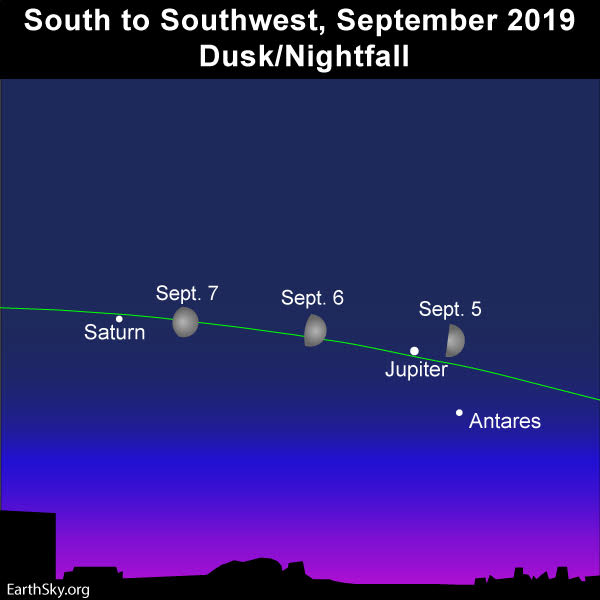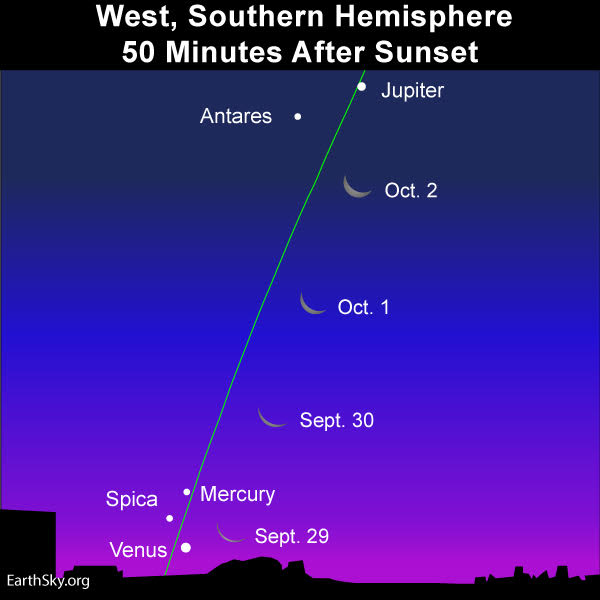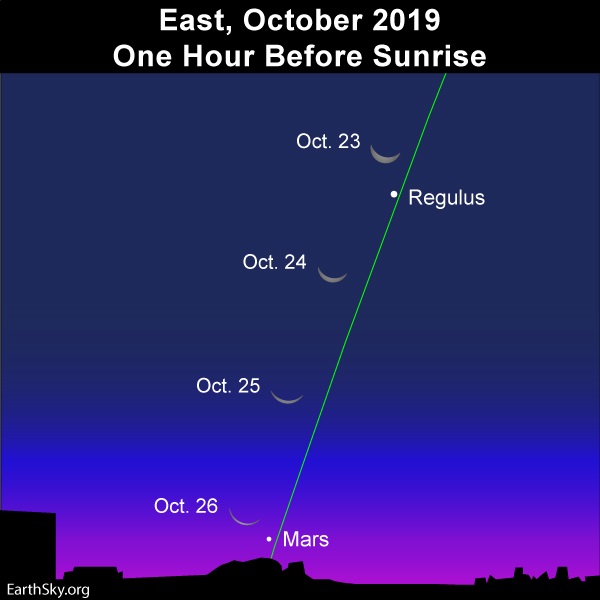
Click the name of a planet to learn more about its visibility in September 2019: Venus, Jupiter, Saturn, Mars and Mercury.

Watch for the moon to pair up with very bright Jupiter around September 5 and fainter, golden Saturn around September 7. Read more. By the way, this chart shows the Northern Hemisphere view, but – from the Southern Hemisphere – the moon is near these same planets on these same approximate dates. For your specific view, try Stellarium Online.
Jupiter – the second-brightest planet after Venus – reigns supreme in the September 2019 night sky. That’s because Venus is sitting close to the glare of sunset all month, leaving dazzling Jupiter to rule the night. Jupiter pops out at dusk – brighter than any star – and stays out until late night. Not sure which one is Jupiter? See the moon in Jupiter’s vicinity for several days, centered on or near September 5. Or just look along the path the sun travels during the day – the ecliptic – for the brightest starlike object you can see. That’ll be Jupiter.
Need more confirmation? Find a bright object you think is Jupiter, steady your binoculars – maybe sit down and anchor them on your knees, or prop your elbows on a fence railing – and aim them at that very bright light. If it is Jupiter, at least one or more of its four largest moons should pop into view.
At mid-northern latitudes in the Northern Hemisphere, Jupiter appears in the south to southwest sky at dusk. In early September, Jupiter sets around midnight (1 a.m. daylight saving time). By midnight, we mean the middle of the night, or midway between sunset and sunrise. By the month’s end, Jupiter sets around 9 p.m. (10 p.m. daylight saving time).
At temperate latitudes in the Southern Hemisphere, Jupiter is found nearly overhead at dusk/nightfall. The king planet sets about an hour after the midnight hour in early September, and then by early October, sets about one hour before midnight.
Try Stellarium Online for the view from your location.
That bright, fiercely twinkling red star – close to Jupiter on our sky’s dome this year – is Antares, the Heart of the Scorpion in the constellation Scorpius. In 2019, sky watchers have been watching Jupiter “wander” east and west relative to this zodiac star. In the first three months of 2019, Jupiter was traveling eastward, away from Antares. Starting on April 10, 2019, Jupiter reversed course, and began moving toward Antares. For four months (April 10 to August 11, 2019), Jupiter traveled in retrograde (or westward), closing the gap between itself and this star. Jupiter is now moving eastward again, away from Antares.

As seen from North America, the moon shines to the west of Saturn on September 7, and then to the east of Saturn on September 8. Read more.
Saturn. After you find Jupiter at dusk and nightfall, use this brilliant beauty of a planet to find another bright evening planet, Saturn. Saturn is not as bright as Jupiter, but the ringed planet shines on par with the sky’s brightest stars. Hold your fist at arm’s length. Saturn is roughly three fist-widths to the east of Jupiter. Because Saturn is the only bright-looking “star” to occupy this part of the sky, you’re not likely to mistake a bright star for Saturn.
Read more: When Jupiter and Saturn meet
Saturn – a golden world to the eye alone – pops out at nightfall and stays out until the wee hours after midnight. This planet – faintest of the major planets visible to the eye in Earth’s sky – still shines as brightly as a 1st-magnitude star, in other words, as brightly as our sky’s brightest stars.
Viewing Saturn’s rings soon? Read me 1st
At mid-northern latitudes, Saturn transits – reaches its highest point for the night – around nightfall. In early September, Saturn sets around one hour after midnight (2 a.m. daylight saving time), and near the month’s end, sets around one hour before midnight (12 a.m. daylight saving time).
At temperate latitudes in the Southern Hemisphere, in early September, Saturn transits – climbs highest up for the night – at early evening, and sets about three hours after the midnight hour. By late September, Saturn transits at evening dusk and sets about one hour after midnight.
You won’t mistake Jupiter for Saturn. Jupiter is significantly brighter than Saturn. Jupiter is the fourth-brightest celestial object after the sun, moon and Venus, respectively, and it outshines Saturn by about 10 times. What’s more, at nightfall and early evening in September 2019, Jupiter shines well to the west of Saturn.
Watch for the bright moon to join up with Saturn around September 7 and 8, as shown on the sky chart above.

At the end of September 2019, it’ll be easier to view the planets Mercury and Venus than it was when this month began. The star Spica – brightest light in the constellation Virgo the Maiden – will be nearby. All of these objects will be easiest to see from Earth’s Southern Hemisphere this month. That’s because the ecliptic – or path of the sun, moon and planets – tilts steeply with respect to the sunset horizon in the autumn, and autumn begins in the Northern Hemisphere on September . Read more.
Mercury and Venus are both nominally evening planets all through September 2019, but both sit way too close to the glare of sunset to be visible at mid-northern latitudes for most of the month. From the Southern Hemisphere, or the northern tropics, you might catch the young moon with both Mercury and Venus near the month’s end, as depicted on the sky chart above.
Note that Venus – the brightest planet – is much brighter than Mercury.
By the way, at Mercury’s most recent inferior conjunction on July 21, 2019, Mercury swung to the south of the sun’s disk as seen from Earth. But when Mercury reaches its next inferior conjunction on November 11, 2019, the innermost planet will swing directly in front of the sun, to stage a transit of Mercury. Transits of Mercury happen more frequently than transits of Venus; they happen 13 or 14 times per century. The last transit of Mercury happened on May 9, 2016, and – after the one on this upcoming November 11 – the next Mercury transit won’t be until November 13, 2032.

You probably won’t see Mars again until late October, 2019. The waning crescent moon will point to Mars on October 23, 24 and 25. On October 26, look for the moon to swing close to Mars on the sky’s dome. Read more.
Where is Mars? Note that the above sky chart is for late October, not September! That’s because late October may feature your first decent chance to catch this world before sunrise. Mars swings on the far side of the sun at superior conjunction on September 2, 2019, to transition from the evening to morning sky. Hiding in the glare of sunrise, Mars probably won’t become visible in the morning sky until late October or November 2019.
What do we mean by bright planet? By bright planet, we mean any solar system planet that is easily visible without an optical aid and that has been watched by our ancestors since time immemorial. In their outward order from the sun, the five bright planets are Mercury, Venus, Mars, Jupiter and Saturn. These planets actually do appear bright in our sky. They are typically as bright as – or brighter than – the brightest stars. Plus, these relatively nearby worlds tend to shine with a steadier light than the distant, twinkling stars. You can spot them, and come to know them as faithful friends, if you try.
Bottom line: In September 2019, two planets – Jupiter and Saturn – are easy to see throughout the month. They both come out at nightfall and are out until late night. Mercury and Venus are pretty much lost in the afterglow of sunset, whereas Mars is hiding in the glare of sunrise. Click here for recommended almanacs; they can help you know when the planets rise and set in your sky.
Don’t miss anything. Subscribe to EarthSky News by email
Visit EarthSky’s Best Places to Stargaze, and recommend a place we can all enjoy.
Help EarthSky keep going! Donate now.
Post your planet photos at EarthSky Community Photos
from EarthSky https://ift.tt/1YD00CF

Click the name of a planet to learn more about its visibility in September 2019: Venus, Jupiter, Saturn, Mars and Mercury.

Watch for the moon to pair up with very bright Jupiter around September 5 and fainter, golden Saturn around September 7. Read more. By the way, this chart shows the Northern Hemisphere view, but – from the Southern Hemisphere – the moon is near these same planets on these same approximate dates. For your specific view, try Stellarium Online.
Jupiter – the second-brightest planet after Venus – reigns supreme in the September 2019 night sky. That’s because Venus is sitting close to the glare of sunset all month, leaving dazzling Jupiter to rule the night. Jupiter pops out at dusk – brighter than any star – and stays out until late night. Not sure which one is Jupiter? See the moon in Jupiter’s vicinity for several days, centered on or near September 5. Or just look along the path the sun travels during the day – the ecliptic – for the brightest starlike object you can see. That’ll be Jupiter.
Need more confirmation? Find a bright object you think is Jupiter, steady your binoculars – maybe sit down and anchor them on your knees, or prop your elbows on a fence railing – and aim them at that very bright light. If it is Jupiter, at least one or more of its four largest moons should pop into view.
At mid-northern latitudes in the Northern Hemisphere, Jupiter appears in the south to southwest sky at dusk. In early September, Jupiter sets around midnight (1 a.m. daylight saving time). By midnight, we mean the middle of the night, or midway between sunset and sunrise. By the month’s end, Jupiter sets around 9 p.m. (10 p.m. daylight saving time).
At temperate latitudes in the Southern Hemisphere, Jupiter is found nearly overhead at dusk/nightfall. The king planet sets about an hour after the midnight hour in early September, and then by early October, sets about one hour before midnight.
Try Stellarium Online for the view from your location.
That bright, fiercely twinkling red star – close to Jupiter on our sky’s dome this year – is Antares, the Heart of the Scorpion in the constellation Scorpius. In 2019, sky watchers have been watching Jupiter “wander” east and west relative to this zodiac star. In the first three months of 2019, Jupiter was traveling eastward, away from Antares. Starting on April 10, 2019, Jupiter reversed course, and began moving toward Antares. For four months (April 10 to August 11, 2019), Jupiter traveled in retrograde (or westward), closing the gap between itself and this star. Jupiter is now moving eastward again, away from Antares.

As seen from North America, the moon shines to the west of Saturn on September 7, and then to the east of Saturn on September 8. Read more.
Saturn. After you find Jupiter at dusk and nightfall, use this brilliant beauty of a planet to find another bright evening planet, Saturn. Saturn is not as bright as Jupiter, but the ringed planet shines on par with the sky’s brightest stars. Hold your fist at arm’s length. Saturn is roughly three fist-widths to the east of Jupiter. Because Saturn is the only bright-looking “star” to occupy this part of the sky, you’re not likely to mistake a bright star for Saturn.
Read more: When Jupiter and Saturn meet
Saturn – a golden world to the eye alone – pops out at nightfall and stays out until the wee hours after midnight. This planet – faintest of the major planets visible to the eye in Earth’s sky – still shines as brightly as a 1st-magnitude star, in other words, as brightly as our sky’s brightest stars.
Viewing Saturn’s rings soon? Read me 1st
At mid-northern latitudes, Saturn transits – reaches its highest point for the night – around nightfall. In early September, Saturn sets around one hour after midnight (2 a.m. daylight saving time), and near the month’s end, sets around one hour before midnight (12 a.m. daylight saving time).
At temperate latitudes in the Southern Hemisphere, in early September, Saturn transits – climbs highest up for the night – at early evening, and sets about three hours after the midnight hour. By late September, Saturn transits at evening dusk and sets about one hour after midnight.
You won’t mistake Jupiter for Saturn. Jupiter is significantly brighter than Saturn. Jupiter is the fourth-brightest celestial object after the sun, moon and Venus, respectively, and it outshines Saturn by about 10 times. What’s more, at nightfall and early evening in September 2019, Jupiter shines well to the west of Saturn.
Watch for the bright moon to join up with Saturn around September 7 and 8, as shown on the sky chart above.

At the end of September 2019, it’ll be easier to view the planets Mercury and Venus than it was when this month began. The star Spica – brightest light in the constellation Virgo the Maiden – will be nearby. All of these objects will be easiest to see from Earth’s Southern Hemisphere this month. That’s because the ecliptic – or path of the sun, moon and planets – tilts steeply with respect to the sunset horizon in the autumn, and autumn begins in the Northern Hemisphere on September . Read more.
Mercury and Venus are both nominally evening planets all through September 2019, but both sit way too close to the glare of sunset to be visible at mid-northern latitudes for most of the month. From the Southern Hemisphere, or the northern tropics, you might catch the young moon with both Mercury and Venus near the month’s end, as depicted on the sky chart above.
Note that Venus – the brightest planet – is much brighter than Mercury.
By the way, at Mercury’s most recent inferior conjunction on July 21, 2019, Mercury swung to the south of the sun’s disk as seen from Earth. But when Mercury reaches its next inferior conjunction on November 11, 2019, the innermost planet will swing directly in front of the sun, to stage a transit of Mercury. Transits of Mercury happen more frequently than transits of Venus; they happen 13 or 14 times per century. The last transit of Mercury happened on May 9, 2016, and – after the one on this upcoming November 11 – the next Mercury transit won’t be until November 13, 2032.

You probably won’t see Mars again until late October, 2019. The waning crescent moon will point to Mars on October 23, 24 and 25. On October 26, look for the moon to swing close to Mars on the sky’s dome. Read more.
Where is Mars? Note that the above sky chart is for late October, not September! That’s because late October may feature your first decent chance to catch this world before sunrise. Mars swings on the far side of the sun at superior conjunction on September 2, 2019, to transition from the evening to morning sky. Hiding in the glare of sunrise, Mars probably won’t become visible in the morning sky until late October or November 2019.
What do we mean by bright planet? By bright planet, we mean any solar system planet that is easily visible without an optical aid and that has been watched by our ancestors since time immemorial. In their outward order from the sun, the five bright planets are Mercury, Venus, Mars, Jupiter and Saturn. These planets actually do appear bright in our sky. They are typically as bright as – or brighter than – the brightest stars. Plus, these relatively nearby worlds tend to shine with a steadier light than the distant, twinkling stars. You can spot them, and come to know them as faithful friends, if you try.
Bottom line: In September 2019, two planets – Jupiter and Saturn – are easy to see throughout the month. They both come out at nightfall and are out until late night. Mercury and Venus are pretty much lost in the afterglow of sunset, whereas Mars is hiding in the glare of sunrise. Click here for recommended almanacs; they can help you know when the planets rise and set in your sky.
Don’t miss anything. Subscribe to EarthSky News by email
Visit EarthSky’s Best Places to Stargaze, and recommend a place we can all enjoy.
Help EarthSky keep going! Donate now.
Post your planet photos at EarthSky Community Photos
from EarthSky https://ift.tt/1YD00CF


Aucun commentaire:
Enregistrer un commentaire